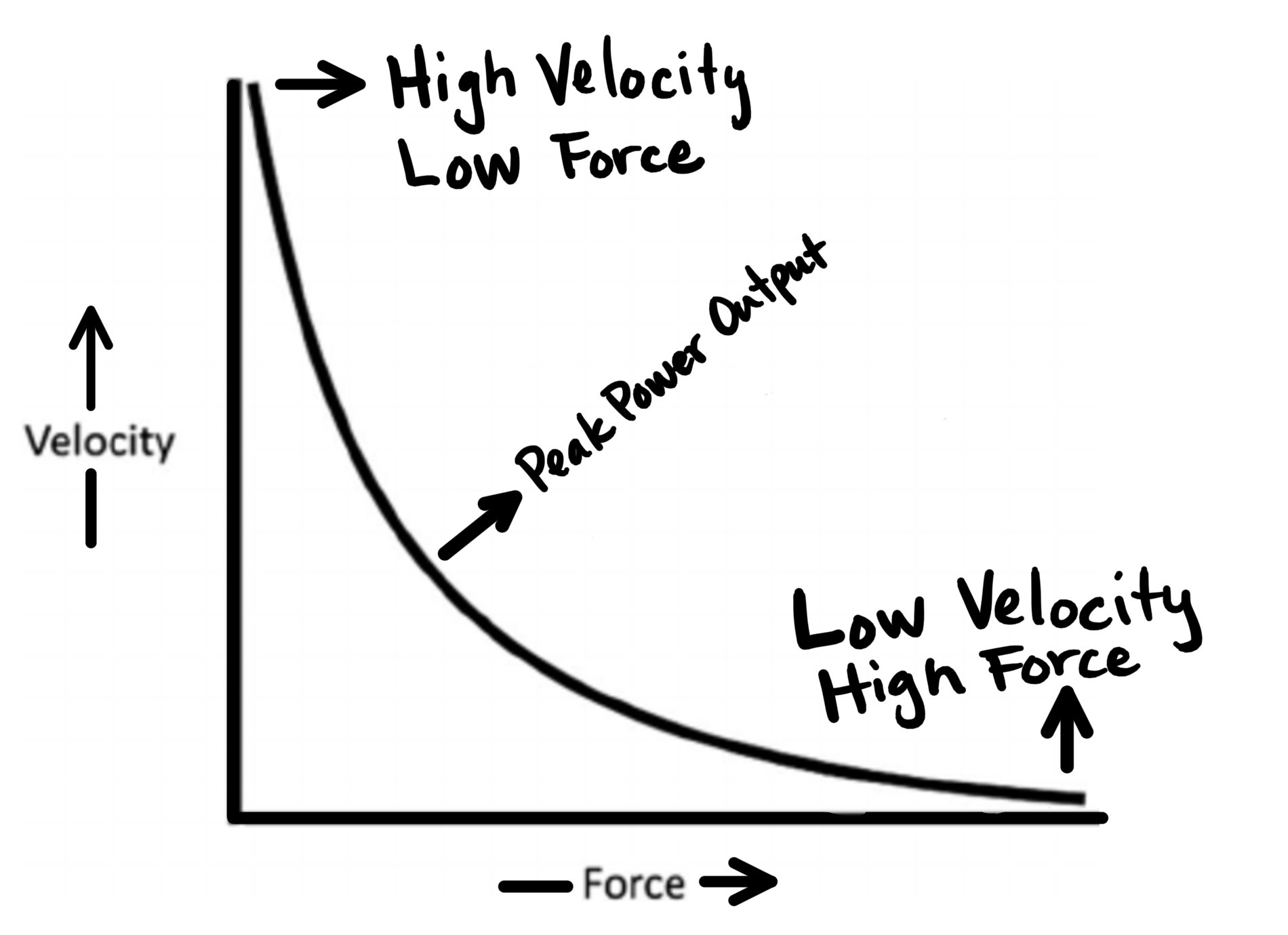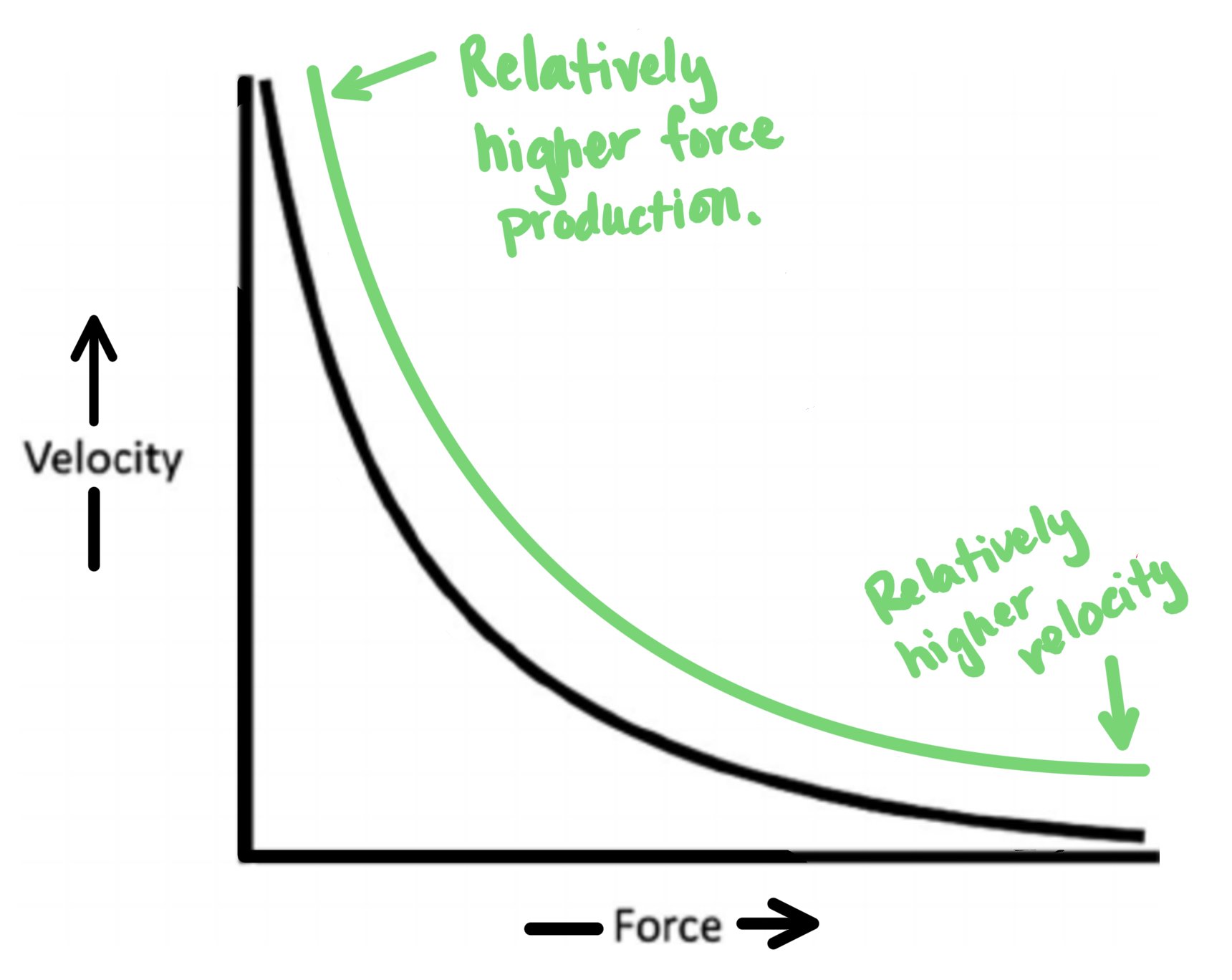golf performance and The force-velocity curve.
Introduction
Golf is a power sport.
I have made that simple statement in several prior blog articles but I feel it bears repeating. Many golfers do not understand this simple fact and the consequences for their golf performance are truly ruinous. One of the fundamental missions of Iconic Motion is to help golfers to understand the unique physical demands of golf. That opening sentence captures much of what the game demands physically: POWER OUTPUT.
If you want to hit the ball further, increasing your power output should be one of the main objectives of your golf oriented fitness routine. Power output is evaluated in the Iconic Motion process and is absolutely vital in forming an improvement plan.
p = F × V
Crucial to the understanding of power is the relationship between power, force and velocity. Mathematically they are related as follows:
Power = Force × velocity
Strength is the amount of force a muscle can exert. Therefore in this discussion the terms “strength” and “force” will be used as synonyms.
Speed refers to how fast a muscle can execute a movement pattern. Therefore in this discussion the terms “velocity”, '“speed" and “quickness” will be used as synonyms.
It is useful to think of this relationship in terms of how fast you can move an implement or object held in hand. As the object gets heavier (more mass) the force required to move it increases but the velocity at which it moves decreases. An example would be lifting a heavy loaded barbell. Conversely, as the object becomes lighter (less mass) the force required to move it decreases but the velocity at which it moves increases. An example would be swinging a golf club.
This can be represented graphically as follows:
The Force-Velocity Curve
The middle of the curve represents peak power output. This is the point on the curve where both force and velocity are maximized.
The demands of golf
You can start to imagine different sports with different demands landing on different points along the curve. For example competitive weight lifting would demand relatively higher amounts of force, but relatively little in terms of velocity. Moving a golf club requires relatively lower amounts of force, but relatively higher velocity.
Notice I’m using the qualifying term: “relatively.”
It is not realistic to describe any activity as being either “force only” or “velocity only.” Rather it is a sliding scale of relativity. A given activity might be more or less biased toward certain ends of the curve, but it is crucial to emphasize that both force and velocity are required for all activities including golf.
The reason this power curve is especially applicable for golfers is the fact that the golf swing occurs in about 1 second. Power is defined as the ability to produce force rapidly. The act of the golf swing occurs in an incredibly compressed time frame in comparison to other sports that unfold over longer stretches of time. Sports like long distance running or cycling can last for hours. Success in those sports depends more on a muscles ability to contract with relatively lower force, but to perform continually for long durations of time. In other words, the emphasis is on muscular endurance, not power. This is a very different challenge from golf. In the case of the golf swing, the golfer needs to produce velocity, but also ramp up to peak force production in a very short amount of time.
What does your curve look like?
Any given athlete might have different abilities or have undergone training that might change the shape of their force-velocity curve. Here are a few examples:
Weak and fast
This athlete is relatively more skilled at velocity or is velocity trained, but they are relatively poor at force production.
Strong and slow
This athlete is relatively more skilled at force production or they have been strength trained but they are relatively poor at speed development.
Weak and slow
This athlete is relatively poor at both force production and speed development suggesting detraining in both areas. The entire curve is pushed down representing relatively decreased peak power output.
Strong and fast
This athlete demonstrates relatively higher output in both force and velocity suggesting training in both areas. The entire curve is pushed up representing increased peak power output.
There are basically an infinite number of possible curves depending on the relative abilities of the athlete. One could imagine this curve would bend and see-saw up or down, depending on the athlete’s training status. (or the lack thereof). You don’t have to be detrained in both properties to affect power output. Relative strength or weakness in either force production or speed production could shift peak power output.
It is useful to break the force-velocity curve into conceptual categories that describe the basic emphasis of that part of the cure. The categories are as follows:
Power Categories
This framework has major implications for training program design. A common misconception is that because swinging a golf club falls mostly in the speed-strength and maximum speed categories, that these are the areas golfers should focus on exclusively and there is little or no benefit to be had from strength work. This is poor logic for a few reasons. First recall that total power output can be influenced by BOTH strength capacity AND speed capacity. If a golfer is already quick but they lack strength and they only do speed work, their curve will continue to be unbalanced in favor of speed and total power output is unlikely to improve. Second, it is unwise to layer speed on top of muscular weakness. Exposing weak muscles to the rapid acceleration and deceleration involved in speed training can introduce injury risk. A solid baseline of strength is a pre-requisite for speed training. Golfers that lack strength but engage in speed training or even just the act of swinging while playing golf are ticking time bombs.
From studying the force-velocity curves of the best golfers in the world, we know that the golfers that can produce force rapidly (higher power output) are the longest hitters giving them a massive scoring advantage.
What is your current ability with respect to force and velocity production? How are you training in relation to your sport? Are you spending an excessive amount of time developing properties that have little or no impact on your physical performance? (i.e. endurance activities) What are you doing now to improve power output? If you find yourself answering “I don’t know” or “nothing” to these questions then I have good news for you: Your potential for improving your club head speed is enormous.
Although power assessment is not the only thing that should be measured in a golf fitness evaluation, it is a major part of a quality assessment. Since every golfer is different, a detailed golf fitness evaluation is crucial if you want a good idea of where you stand on the force-velocity curve.
If you are interested in discovering ways to boost your power output, I invite you to click here and schedule a free consultation. I would love to have a conversation about how I might help.







